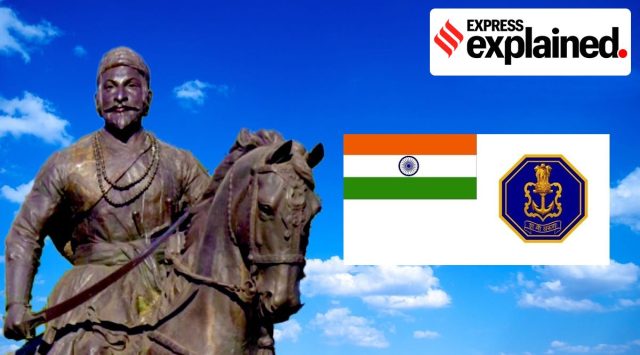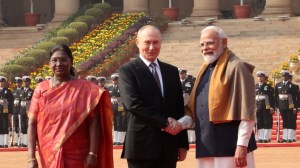New Naval Ensign: The naval prowess of Chhatrapati Shivaji that has always inspired the Indian Navy
Indian Navy New Naval Ensign Explained: The formidable exploits of the Maratha navy under Shivaji and later, the celebrated admiral Kanhoji Angre, ensured safe and secure maritime trading in the Arabian Sea.
 Indian Navy’s new ensign unveiled: The flag is inspired by Chhatrapati Shivaji Maharaj.
Indian Navy’s new ensign unveiled: The flag is inspired by Chhatrapati Shivaji Maharaj.Prime Minister Narendra Modi unveiled the new Naval Ensign (flag) at Kochi on Friday (September 2), which bears the seal of Chhatrapati Shivaji Maharaj, who laid the foundations of a modern navy.
Shivaji’s navy gave his enemies sleepless nights, the Prime Minister said, and this was the reason that the British colonialists decided to break the back of the Indian naval enterprise.
इसलिए उन्होंने भारत के समुद्री सामर्थ्य की कमर तोड़ने का फैसला लिया।
इतिहास गवाह है कि कैसे उस समय ब्रिटिश संसद में कानून बनाकर भारतीय जहाजों और व्यापारियों पर कड़े प्रतिबंध लगा दिए गए: PM @narendramodi
— PMO India (@PMOIndia) September 2, 2022
But now, the Indian Navy’s new flag, inspired by Shivaji, will fly proudly in the sky and on the seas, the Prime Minister said.
अब तक भारतीय नौसेना के ध्वज पर गुलामी की पहचान बनी हुई थी।
लेकिन अब आज से छत्रपति शिवाजी से प्रेरित, नौसेना का नया ध्वज समंदर और आसमान में लहराएगा: PM @narendramodi
— PMO India (@PMOIndia) September 2, 2022
How does the Indian Navy identify with Shivaji (reign 1674-80) and the great Maratha admiral Kanhoji Angre (1669-1729), and how did they ensure Maratha supremacy of the seas?
Shivaji and the seas
Chhatrapati Shivaji Maharaj put great emphasis on sea-faring prowess, and laid the foundations of a modern naval force in the 17th century. The Indian Navy has always acknowledged this fact, and has named a training establishment in Lonavla as INS Shivaji and a shore based logistics and administrative hub of Western Naval Command, Mumbai, as INS Angre after Kanhoji Angre, the acclaimed Maratha naval commander.
The use of the octagonal design of the seal of Shivaji on the new Naval Ensign is a formal stamp on the umbilical ties of the Indian Navy with the navy of the Maratha empire.
The new Naval Ensign unveiled by @PMOIndia Shri @narendramodi on #02Sep 22, during the glorious occasion of commissioning of #INSVikrant, first indigenously built Indian Aircraft Carrier & thus, an apt day for heralding the change of ensign.
Know all about the new Ensign ⬇️ pic.twitter.com/ZBEOj2B8sF
— SpokespersonNavy (@indiannavy) September 2, 2022
Extent of naval prowess
Shivaji’s strategic thought ensured that a strong naval presence was established along the Konkan coast to protect the sea trade of the Maratha empire. As per an Indian Navy document, “The navy under Shivaji was so strong that the Marathas could hold their against the British, Portuguese and Dutch. Shivaji realised the importance of having a secure coastline and protecting the western Konkan coastline from the attacks of Siddis’ fleet”.
Shivaji built ships in towns such as Kalyan, Bhivandi, and Goa, both for trade and to establish a fighting navy. “He also built a number of sea forts and bases for repair, storage and shelter. Shivaji fought many lengthy battles with Siddis of Janjira on coastline. The fleet grew to reportedly 160 to 700 merchant, support and fighting vessels. He started trading with foreigners on his own after possession of eight or nine ports in the Deccan,” the Navy document states.
Kanhoji Angre
Kanohji Angre was the commander of Maratha navy, and is credited with laying a strong naval foundation which ensured that the Marathas were a sea-faring power to reckon with.
Kanhoji is credited with holding his own against the English, Portuguese and Dutch naval forces. He ensured that the merchants plying their trade for the Maratha empire were protected on the seas. He set up a base in Colaba with more bases at Suvarndurg and Vijaydurg near Ratnagiri.
In the estimation of many historians, Kanhoji was the greatest naval commander in pre-modern Indian history. Before the Marathas, the Cholas had a formidable sea-faring fleet of ships which, though not being strictly warships, were able to lead expeditions all around the Bay of Bengal.
- 01
- 02
- 03
- 04
- 05






































